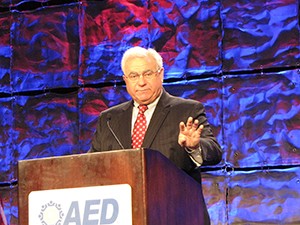
Equipment markets are starting to return, according to dealers who convened in Houston on Jan. 16-17 for the Associated Equipment Distributors’ 2014 AED Summit.
The market drop in 2008 and 2009 was about a 50% hit on new equipment; however, sales are growing again, said Ron Slee, a Rancho Mirage, Calif.-based industry consultant.
“They’re about a quarter to a third lower than where we were in 2007,” he said. “But we’re feeling better because equipment’s getting better.” The dealer's market share on parts is likely no more than 30%, while service was around 20%, he added.
“One of the things that’s interesting in our industry is, from an equipment perspective, we’re measured in market share to about the 20th decimal place. In parts and service, we haven’t got a clue,” Slee explained. “So, all of us that focus in the parts and service are given a pass on performance, which has always bothered me.
"Somewhere at some time, we had 100% market share on labor," Slee continued. "If we don’t pay attention, we’re going to lose our market share altogether when, at the same time, manufacturers are trying desperately to help us."
More than 100 firms exhibited their latest equipment offerings as part of the meeting's two-day CONDEX trade show, while panelists from across industry lines gathered during the educational and keynote sessions to discuss the state of the dealership business.
Marty Regalia, senior vice president for economic and tax policy and chief economist at the U.S. Chamber of Commerce, acknowledged that the economy has grown, meaning positive things for equipment dealers. But several hurdles remain.
“We’ve seen consumption pick up for two reasons: Income growth has continued at a fairly modest pace, but at least it has been positive. So, total payroll has gone up,” Regalia said, adding that personal wealth decreased by $15 trillion during the recession but is climbing back again.
"We’ll see a willingness for consumers to spend to increase,” he said.
The second reason for the rise in consumption, according to Regalia, is that investment is going to gradually come back as the economy picks up and gains momentum.


Post a comment to this article
Report Abusive Comment